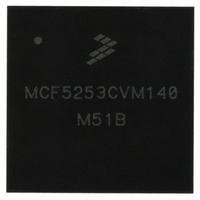MCF5253CVM140 Freescale Semiconductor, MCF5253CVM140 Datasheet - Page 547

MCF5253CVM140
Manufacturer Part Number
MCF5253CVM140
Description
IC MPU 32BIT 140MHZ 225-MAPBGA
Manufacturer
Freescale Semiconductor
Series
MCF525xr
Datasheets
1.MCF5253VM140J.pdf
(34 pages)
2.MCF5253VM140J.pdf
(8 pages)
3.MCF5253VM140J.pdf
(648 pages)
4.MCF5253VM140J.pdf
(2 pages)
Specifications of MCF5253CVM140
Core Processor
Coldfire V2
Core Size
32-Bit
Speed
140MHz
Connectivity
CAN, EBI/EMI, I²C, QSPI, UART/USART, USB OTG
Peripherals
DMA, WDT
Program Memory Type
ROMless
Ram Size
128K x 8
Voltage - Supply (vcc/vdd)
1.08 V ~ 1.32 V
Data Converters
A/D 6x12b
Oscillator Type
External
Operating Temperature
-40°C ~ 85°C
Package / Case
225-MAPBGA
Family Name
MCF5xxx
Device Core
ColdFire V2
Device Core Size
32b
Frequency (max)
140MHz
Instruction Set Architecture
RISC
Supply Voltage 1 (typ)
1.2/3.3V
Operating Supply Voltage (max)
1.32/3.6V
Operating Supply Voltage (min)
1.08/3V
Operating Temp Range
-40C to 85C
Operating Temperature Classification
Industrial
Mounting
Surface Mount
Pin Count
225
Package Type
MA-BGA
Lead Free Status / RoHS Status
Lead free / RoHS Compliant
Number Of I /o
-
Eeprom Size
-
Program Memory Size
-
Lead Free Status / Rohs Status
Compliant
Available stocks
Company
Part Number
Manufacturer
Quantity
Price
Company:
Part Number:
MCF5253CVM140
Manufacturer:
FREESCALE
Quantity:
300
Company:
Part Number:
MCF5253CVM140
Manufacturer:
Freescale Semiconductor
Quantity:
10 000
Part Number:
MCF5253CVM140
Manufacturer:
FREESCALE
Quantity:
20 000
Company:
Part Number:
MCF5253CVM140J
Manufacturer:
Freescale Semiconductor
Quantity:
10 000
- MCF5253VM140J PDF datasheet
- MCF5253VM140J PDF datasheet #2
- MCF5253VM140J PDF datasheet #3
- MCF5253VM140J PDF datasheet #4
- Current page: 547 of 648
- Download datasheet (8Mb)
One queue head is used to manage the data stream for one endpoint. The queue head structure contains
static endpoint characteristics and capabilities. It also contains a working area from where individual bus
transactions for an endpoint are executed. Each qTD represents one or more bus transactions, which is
defined in the context of the EHCI specification as a transfer.
The general processing model for the host controller's use of a queue head is simple:
If the host controller encounters errors during a transaction, the host controller will set one of the error
reporting bits in the queue head's Status field. The Status field accumulates all errors encountered during
the execution of a qTD (that is, the error bits in the queue head Status field are sticky until the transfer
(qTD) has completed). This state is always written back to the source qTD when the transfer is complete.
On transfer (for example, buffer or halt conditions) boundaries, the host controller must auto-advance
(without software intervention) to the next qTD. Additionally, the hardware must be able to halt the queue
so no additional bus transactions will occur for the endpoint and the host controller will not advance the
queue.
24.9.10.1 Buffer Pointer List Use for Data Streaming with qTDs
A qTD has an array of buffer pointers, which is used to reference the data buffer for a transfer. The EHCI
specification requires that the buffer associated with the transfer be virtually contiguous. This means that
if the buffer spans more than one physical page, it must obey the following rules:
Figure 24-51
Freescale Semiconductor
•
•
•
•
•
•
Read a queue head
Execute a transaction from the overlay area
Write back the results of the transaction to the overlay area
Move to the next queue head
The first portion of the buffer must begin at some offset in a page and extend through the end of
the page.
The remaining buffer cannot be allocated in small chunks scattered around memory. For each 4K
chunk beyond the first page, each buffer portion matches to a full 4K page. The final portion, which
may only be large enough to occupy a portion of a page, must start at the top of the page and be
contiguous within that page.
illustrates these requirements.
MCF5253 Reference Manual, Rev. 1
Universal Serial Bus Interface
24-85
Related parts for MCF5253CVM140
Image
Part Number
Description
Manufacturer
Datasheet
Request
R
Part Number:
Description:
Mcf5253 Coldfire? Microprocessor Data Sheet
Manufacturer:
Freescale Semiconductor, Inc
Datasheet:
Part Number:
Description:
Manufacturer:
Freescale Semiconductor, Inc
Datasheet:
Part Number:
Description:
Manufacturer:
Freescale Semiconductor, Inc
Datasheet:
Part Number:
Description:
Manufacturer:
Freescale Semiconductor, Inc
Datasheet:
Part Number:
Description:
Manufacturer:
Freescale Semiconductor, Inc
Datasheet:
Part Number:
Description:
Manufacturer:
Freescale Semiconductor, Inc
Datasheet:
Part Number:
Description:
Manufacturer:
Freescale Semiconductor, Inc
Datasheet:
Part Number:
Description:
Manufacturer:
Freescale Semiconductor, Inc
Datasheet:
Part Number:
Description:
Manufacturer:
Freescale Semiconductor, Inc
Datasheet:
Part Number:
Description:
Manufacturer:
Freescale Semiconductor, Inc
Datasheet:
Part Number:
Description:
Manufacturer:
Freescale Semiconductor, Inc
Datasheet:
Part Number:
Description:
Manufacturer:
Freescale Semiconductor, Inc
Datasheet:
Part Number:
Description:
Manufacturer:
Freescale Semiconductor, Inc
Datasheet:
Part Number:
Description:
Manufacturer:
Freescale Semiconductor, Inc
Datasheet:
Part Number:
Description:
Manufacturer:
Freescale Semiconductor, Inc
Datasheet:











